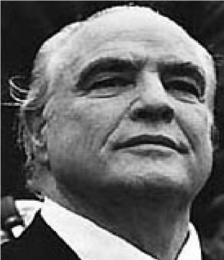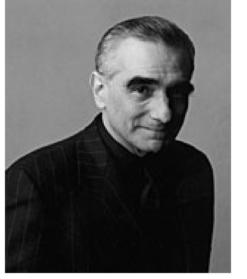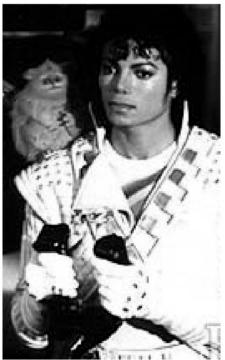Jacko, His Rise and Fall: The Social and Sexual History of Michael Jackson (46 page)
Read Jacko, His Rise and Fall: The Social and Sexual History of Michael Jackson Online
Authors: Darwin Porter

The Bubbles and Michael stories weren't the only tales relayed through
the tabloids during 1984. At the peak of his career, Michael received tributes
as well as condemnations. The News of the World's color supplement hailed
him as "The World's Hottest Property." But Britain's Melody Maker magazine
put him on its list of "Ten Fruitcakes," because he bathed in Perrier water and
talked to inflatable geese. There was a report that he was working on a new
project, a video in which he'd wear a purple dress that catches on fire.
The Fashion Foundation of America's 43rd annual survey of custom tailors and designers named President Reagan, The Catholic Archbishop of New
York City, and Michael Jackson as America's best dressed men-all that in
spite of the archbishop's gowns and Michael's tacky military outfits.
In Sevran, France, in July of 1984, an "obsessed" teenage boy committed
suicide when his parents refused to finance plastic surgery to make him look
like his idol, Michael Jackson.
Michael was extremely upset by this report of a suicide and turned to
Miko Brando for support. (Miko happened to be not only Michael's security
guard, but the second-eldest son of actor Marlon Brando and Marlon's second
wife, Movita Castenada.) Michael had grown closer to Miko after his security guard had put out the fire in his hair during the filming of the Pepsi commercial.
With Miko Brando employed by Michael, it was inevitable that he would
eventually meet The Godfather himself. He'd seen the film fifteen times, as
he was as fascinated by crime pictures as he was by Disney cartoons. Michael
told friends, "Now that I'm the biggest entertainer in the world, I need to associate with names as big as me. Jackie Onassis, and, yes, Marlon Brando.
Perhaps Elizabeth Taylor one day."
The "odd couple" friendship of Michael and Marlon began in the living room of Marlon's home on Mulholland Drive in
Los Angeles. Before an astonished Michael,
Marlon placed a $10,000 check on his coffee
table. He asked Michael for an I.O.U. for the same
amount. The request flabbergasted Michael until
Marlon explained that it was a contest. "Whoever
lets out the biggest fart takes home the prize,"
Marlon said. "I have to warn you, I've been eating
beans all afternoon."

Marlon Brando
Michael giggled and covered his face, later
claiming that Marlon "had a potty mouth." But he
kept returning to Brando's home time and time
again, and Marlon also became a frequent house guest at Neverland.
Sometimes Quincy Jones joined Michael for an evening with Marlon.
Jones and Marlon had known each other since the late 1940s when the actor
was appearing as Stanley Kowalski in Tennessee Williams's A Streetcar
Named Desire on Broadway. With fellow actor Sidney Poitier, Marlon used to
hang out with Jones late at night at Small's Paradise in Harlem. Marlon
regaled Michael with stories of his early days in New York, when he always
wore a red fedora hat. Jones was at Marlon's side when they attended the
funeral of the assassinated Dr. Martin Luther King Jr. Jones always called
Marlon "Leroy," and Michael was envious of the bond between the two longtime friends.
"Tennessee always confused the real me with the fictional character of
Stanley Kowalski," Marlon said to Jones. "And Michael still thinks of me as
Don Corleone."
When Michael told Marlon that Jackie Onassis was going to be the editor
of his autobiography, Moonwalk, Marlon leaned back on his sofa. "I fucked
her but just once. She told me that it was the best fuck of her life."
"Now, Marlon, you know she wouldn't talk dirty like that," Michael said.
Ignoring him, Marlon went on, "I fucked Nancy Davis before she married
Ronald Reagan. But I never got around to Pat Nixon, Bess Truman, or Mamie
Eisenhower."
"Oh, Marlon," Michael said, covering his ears, which he would always do
whenever he thought Marlon was "talking vulgar."
Their friendship began gradually but deepened in the 1990s. Toward the
end of his life, Marlon was telling his friends, "Michael Jackson is my best
comrade-in-arms."
The biggest project between Marlon and Michael never got off the
ground. Marlon worked on a screen treatment, which he hoped to present to
director Martin Scorsese. In the proposed scenario, Marlon cast himself as God, with Michael playing the Devil. "It's typecasting, of course," Marlon
facetiously told Michael.
Alarmed over Marlon's burgeoning weight, Michael arrived one night
bringing Marlon fresh vegetables from his organic garden. What made the
evening rather bizarre was that Michael arrived dressed in a pink-and-chartreuse Pinocchio outfit, complete with a long nose.
"I'm astonished to see you as Pinocchio," Marlon said.
"I like to dress up," Michael said.
"I know that," Marlon said. "It's the big nose I don't get. I thought you'd
spent millions of dollars on plastic surgery trying to get rid of a big nose."
Marlon found that a friendship with Michael had fringe benefits. It was
reported that he used Michael as his personal bank, at one point borrowing a
million dollars from him.
Regardless of the stress Marlon faced in his life, Michael was there for
him. He idolized Marlon and came to regard him as a father figure.
Marlon was no great father, no more than Michael's real father, Papa Joe,
had been. Except for Miko, Marlon had two dysfunctional children, Christian
and Cheyenne. One night Christian shot Cheyenne's lover and was sentenced
to ten years in prison for the assassination. Cheyenne was pregnant at the time
of the slaying.
She'd later accuse Marlon of molesting her, and eventually, at the age of
25, she would commit suicide. Throughout this painful ordeal, Michael stood
by Marlon. When charges of child molestation were raised against Michael,
many of his other famous friends deserted him. Marlon, however, along with
Elizabeth Taylor, was there for Michael. "He did the same for me," Marlon
told his friends. "I can't turn my back on him now. Molestation charges have
been raised against me too. I know what it feels like."
Michael had confided in Marlon that he was suffering emotional distress
over Janet's marriage to James DeBarge and that he was delighted when Janet
eventually filed a petition to nullify the marriage.

Martin Scorsese
Marlon tried to soothe his nerves, telling him,
"I'm emotionally distressed over my own marriages, such as they were. My final conclusion is
this: No man should ever marry and obligate himself to a woman. A man should be free. Even
when I was married, I still insisted on being a free
man. Sometimes I brought my girlfriends home to
meet my wife ... or wives."
"I'll never get married," Michael promised
him.
"You know, I can believe that." Marlon chuckled at his own humor.
Michael shared with Marlon his experiences in filmmaking and often
asked the actor-sometimes hailed as the greatest of the 20th century-for
advice. Francis Ford Coppola, who had directed Marlon in The Godfather,
was also directing Michael in a 17-minute film for Disney, which would be
released in 1986. Steven Spielberg, Michael's friend, was originally going to
direct but had to cancel because of a conflict in his schedule. Cast opposite
Michael as Captain EO was Anjelica Huston, playing The Supreme Leader.
Amazingly, the film took more than a year to shoot and cost $20 million,
which, of course, was more than a million dollars a minute. It ranks as the
costliest short ever made.
Michael was cast as an intergalactic song-and-dance man fighting to save
a planet from the evil designs of the villain, Anjelica Huston. Disney characters such as Captain EO's flying space monkey, "Fuzzball," pop in and out.
Michael tested Coppola's nerves in this musical sci-fi short by refusing to
work on Mondays. He would only rehearse while wearing his sunglasses on a
stage that was completely dark. Coppola couldn't even see his moves, much
less direct them. He couldn't have heard the director's cues anyway because
Michael demanded that the background music be played at full blast.
He had an infuriating habit of disappearing right before he was to be in
one of his scenes. Actually, he was often hiding behind a prop. After the crew
had searched frantically for him, with production costs mounting, he would
suddenly appear on the set. "I don't know why you're complaining," he told
Coppola. "I've been right here all along, waiting to go on."
Other than getting overpaid, Michael found a fringe benefit in working on
Captain EO. It came in a ten-year-old package named Jonathan Spence.
Members of the crew reported to Todd Gold, a
reporter for People, that the cuddly twosome
would "hug and nuzzle a lot." Reportedly, nothing
sexual was going on, but that didn't stop crew
members from gossiping behind Michael's back.
The blond-haired actor was called "an early version of Macaulay Culkin."

MJ in Captain EO
Little Jonathan seemed a devoted companion
to Michael during filming. Not only did he fetch
him such delights as a freshly made glass of
chilled passion fruit juice, but he could be seen
mopping Michael's brow after rehearsal.
When not resting, Jonathan and Michael
dueled with water pistols. One day a food fight
caused $3,000 worth of damage in Michael's expensive trailer. Michael was also fond of ordering custard pies. He and
Jonathan would "ambush" crew members in ways that evoked slapstick comedies from the silent screen. "When I got a pie in the face, I wanted to choke
the shithead," one crew member said in disgust. "But he was the Michael
Jackson, and I didn't want to cross the faggot. He was a diva. There's never
been a greater diva in all of Hollywood than Miss Jackson."
When Coppola's final cut for the ultra-expensive video was approved,
Disney planned a release of the film at only two specially constructed theaters-one at the Epcot Center at Disney World in Orlando and the other at
Disneyland in Anaheim.
At the September 21, 1986 premiere of Captain EO at Disneyland, a nonstop 60-hour party was staged that drew such names as Jane Fonda, Jack
Nicholson (who showed up with co-star Anjelica Huston), Sissy Spacek, and
George Lucas. The only no-show was Michael himself. Actually he was spotted at Disneyland that day, wearing a large black hat and hiding behind a
heavy gray beard. He was seen boarding the roller-coaster called "Space
Mountain."
Captain EO was hardly a triumph for Michael. One of his young fans,
Joseph P. Ulibas, said, "I saw it and was disappointed even at my young age.
Dude, they promised me a movie, and all I got was some singing, dancing, and
overacting. They burned a ton of money on this `movie.' What I would like to
know is what did they spend it on? For one thing, it wasn't on acting lessons.
I can tell you that for sure."
To generate news before the premiere of Captain EO, and in a moment of
indiscretion, Michael launched a secret publicity campaign to show the world
that he was "bizarre," not that anyone on the planet needed much convincing
at this point.
That was the word he wanted to be characterized as, although later this
campaign would spin out of control and backfire on him. He set out to tantalize the press with his eccentricities, and the media, especially the tabloids, not
only bought his self-styled "bizarre" act but invented stories of their own,
making Michael appear far more idiosyncratic than he already was.